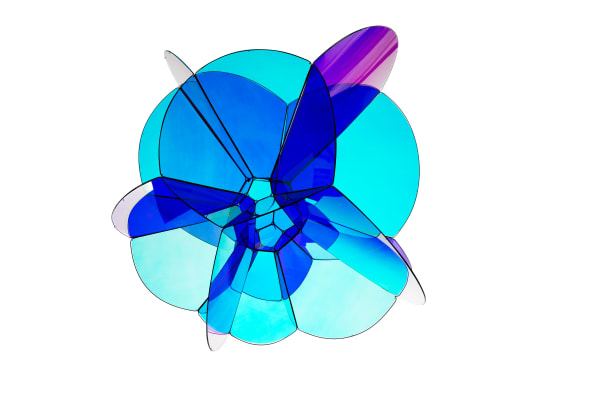
Material tactility, its possibilities, limitations, and transformation form the core of Kelly Akashi's practice. Originally trained in analog photography, traditional processes and the materiality of documents continue to inform and fuel her sculptural explorations. Working in a variety of media, such as wax, bronze, fire, glass, silicone, copper, and rope, Akashi investigates the capacity and boundaries of these elements and their ability to construct and challenge conventional concepts of form.


This body of work, titled ...and to draw a bright, white line with light, was produced for a major solo exhibition at the Art Institute of Chicago. The title is a play on the translation of the word photography which means "to draw with light." It also references the metaphorical idea that photography is "the pencil of nature," as well as the activity of "drawing" a curtain. In this series, undulating curves were made by the movement of a curtain, with Barth actually manipulating light and shadow instead of just observing it. Indeed, photography is always about light and exposure, yet here Uta is using light in an almost sculptural or performative way, participating in the movement as she captures it.


Hysteria is such a big word, one that carries the weight of literature in relation to health, female maladies, and history. This work, cut from a single panel of aluminum that is hand mirror polished, has a dollar sign replacing the S. Hy$teria refers to advertisement and street culture in connection to the first classic psychoanalytic treatise by Freud (together with Josef Breuer), Studies on Hysteria (1895). Bonvicini blurs the lines of meaning, addressing the symbolic dominance of language, rendering the word much more global and contemporary, and opening a large and discursive and political space that is complex, condensed, and not least, extremely current.

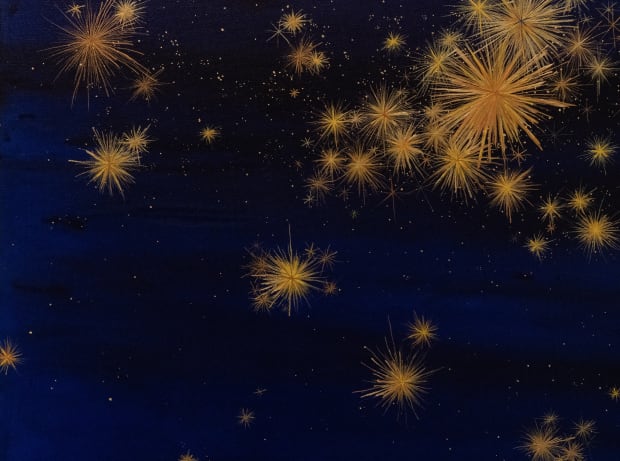
Since the early 1990s, Sandra Cinto has explored the potential of drawing to create intricate images and immersive environments, often using the line as gesture to deconstruct physical and spiritual boundaries. In Night with Stars IV, Cinto renders a mesmerizing nightscape that evokes a sense of weightlessness like that of the sea and the sky. In all her work, Cinto conjures great tensions and contradictions: formally, between surface and depth, abstraction and representation, but also thematically, between joy and sadness, fear and comfort, utopia and reality.
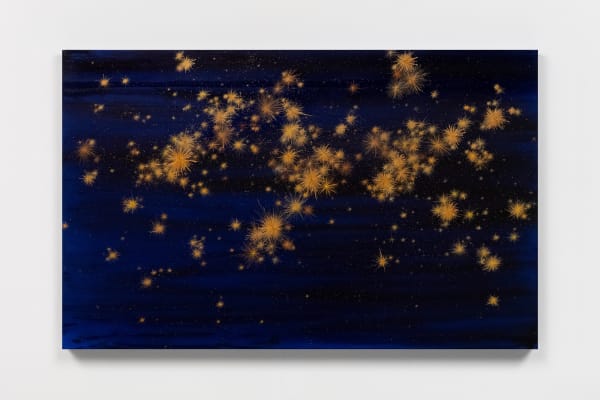

The Dewdrop agora consists of glass spheres of different sizes, densely packed into a circular composition. Viewed from the front, the spheres appear to be entirely infused with color. As viewers move around the artwork, however, their perspectives change and the color emerges and disappears. This effect is created by covering the back portion of each glass sphere with a single hue of transparent paint followed by a layer of silvering, to make them reflective. The concave reflective surface produces an inverted image of the viewers and their surroundings within each sphere, a dynamic image that disappears when the ring is approached from an angle; viewed obliquely, the clarity of the glass re-emerges.
Olafur Eliasson’s major solo exhibition in South-East Asia opens at the Singapore Art Museum on May 10th, 2024. A solo presentation of his work opens at the Istanbul Museum of Modern Art, Turkey, on June 7th. In September 2024, Eliasson will present a new site-specific installation opening at The Geffen Contemporary at MOCA, Los Angeles.


Eliasson's glass works are inspired by the themes of colour, transparency, and layering – topics he first began addressing in a series of delicate watercolour paintings. Central to both is the prominent use of circles and ellipses. Eliasson has long been fascinated by the ellipse’s visual ambiguity, since it can appear to be either a two-dimensional shape or a disc viewed in perspective, depending on the context.
Presented on a driftwood shelf, this array of colourful hand-blown glass sheets combines to create a range of hues in addition to those present in the panes. Circular and elliptical cut-outs allow surprising tones to shine through the layers. The panes of glass are roughly organised into four parts, with a large cut-out ellipse extending across the two central sections. The reflective coating of several of the other ellipses incorporates the viewer into the composition.
The driftwood shelf comes from wood salvaged by the artist from the coast of northern Iceland. Since 2008 Eliasson has collected these large tree trunks, which wash up on the beaches in Iceland from as far away as Siberia. Driftwood was long an important source of lumber in the island country, where less than one per cent of the land is covered with forest. Here, the driftwood support has been planed into a shelf on one side and left raw on the other, revealing the traces of its long journey through the Arctic.


AUDISTRY2.audio/tapestry-isl.Hljóðteppi2 is a two-channel sound installation made of 473 small LCD/TV speakers woven together.
The audio includes field recordings and found sounds of birds and crackling fire scavenged from the world wide web. The artist’s own voice is also heard in ASMR-like whispers. The audio is treated and processed with the intention of creating a momentary safe space for the listener. One small speaker is rigid and solid, but when many are woven together in Audistry2, they become a malleable fabric that adopts organic shapes.
Jónsi’s solo presentation at the Reykjavik Art Museum, Iceland opens on June 1st.
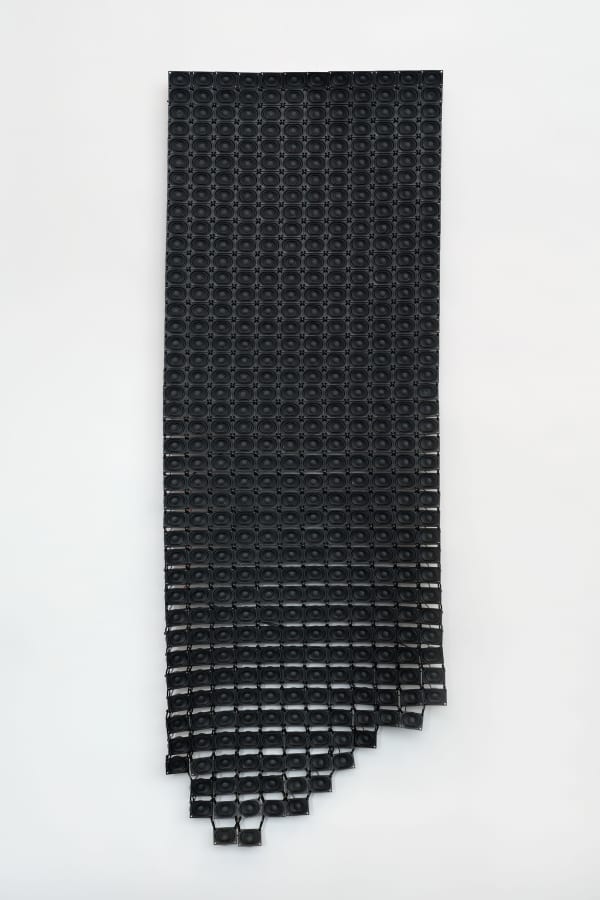

The bottari—a traditional Korean bundle used to wrap and protect personal belongings—has become a central form, both physically and conceptually, in Kimsooja's practice. Representative of essential belongings and a nomadic lifestyle, the bottari is also a metaphor to refer to the universal concept of home and migration, but also to a transitory state.
Kimsooja currently has a solo exhibtion at the gallery in New York, as well as a major presentation at Bourse de Commerse in Paris, France.
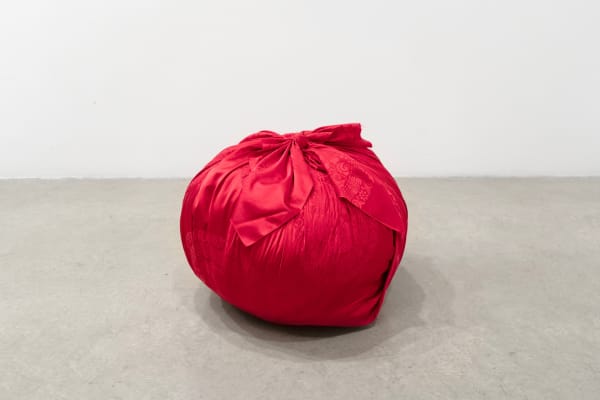

Early in his practice, Manders created his Notional Newspapers. He has recently completed his project to include every word in the English language—used only once and placed in random order. Rather than using real newspapers in his work, these non-sensical fragments have no connection to a specific place or time. Further, the newspapers' traditional purpose as a carrier of language and meaning is undermined and the material is repeatedly transformed.
In Composition with Yellow (Composition with all Existing Words), these words are obscured and painted over. In choosing the color yellow, Manders alludes to the multitudes that language may contain; thus yellow can convey a range of associations, feelings and memories. For instance, looking at Van Gogh's sunflower paintings and the particular yellow that the artist chose - a specific shade that Manders describes as warm yet almost poisonous. And so, yellow offers itself as a chameleon-like construct to be transformed by the artist to communicate an endless variety of emotions.
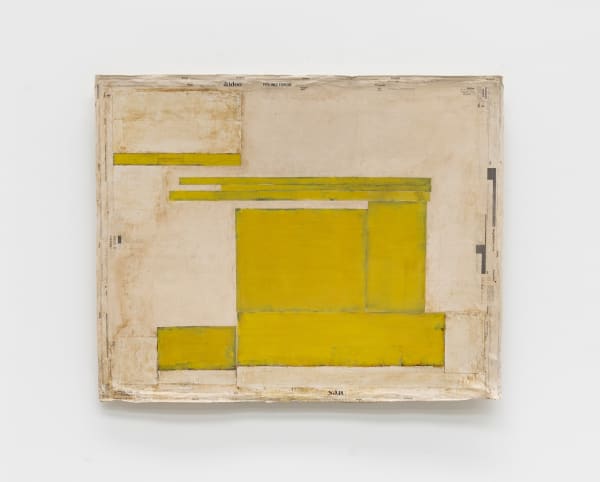
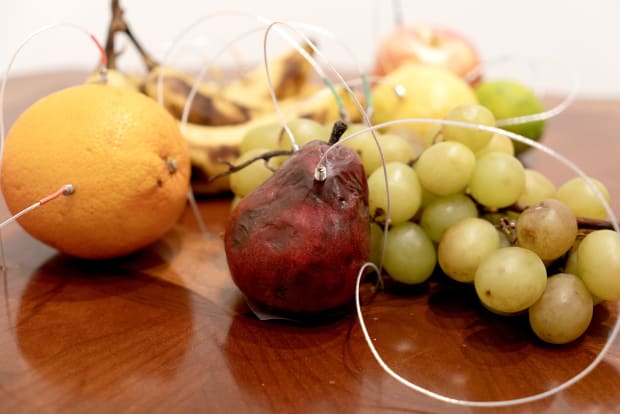
In Yuko Mohri’s Decomposition, she inserts electrodes into fruit to measure their internal moisture levels and converts changes in resistance, caused by withering or rotting, into sound.
Decomposition translates minuscule changes occurring inside fruit into harmonies, conveying the life of fruit that continues to emerge and evolve even after its connection to the soil or tree trunk has been severed. Hinting at the history of still-life painting, Mohri’s work questions the relation between stillness and liveliness, revealing that what might seem without life is actually full of it. As the fruits dry over time, the fruitsʼ resistance grows, and consequently the pitch of the composition rises.
Yuko Mohri is representing Japan in the 60th Venice Biennale, open through November 24, 2024.


In this new body of photographic work, Olivier explores themes of displacement, migration, and absence using discarded items and common construction materials. Combining these with photographic imagery, Olivier asks the viewer to reflect on building practices, excess consumption, and Western ideas of progress in late capitalist societies.
Karyn Olivier's work is currently included in the Whitney Biennale, on view until August 11th.
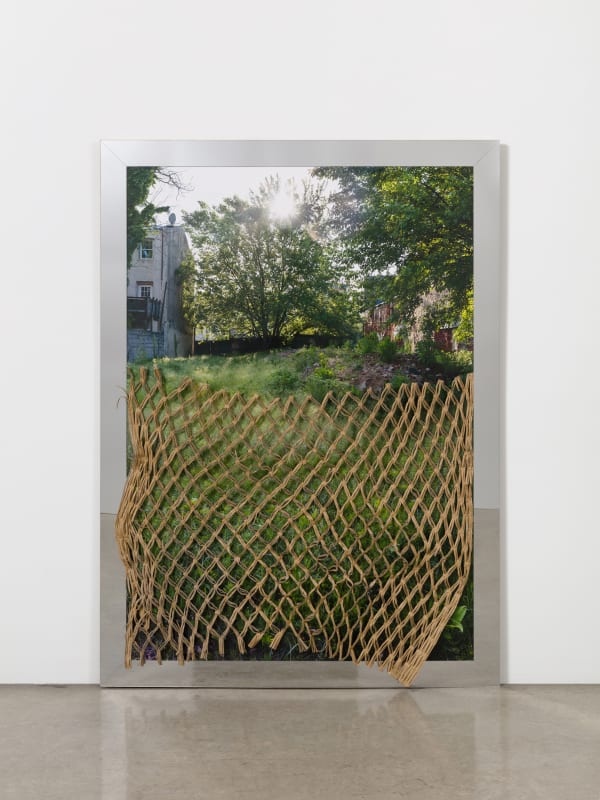

In her research on Nazi looted art in the Netherlands for a solo exhibition at the Huis Marseilles in Amsterdam, Oppenheim came across the intriguing story of Jacques Goudstikker, owner of one of the best known prewar art galleries in the Netherlands: Kunsthandel J. Goudstikker N.V, which specialized in Dutch and Flemish Old Masters paintings.
Immediately after war broke out in May 1940, Goudstikker (who was Jewish) fled to the United Kingdom by boat with his wife Desirée Halban and small son, Eduard. One of the few things he was able to take with him was a small black notebook containing detailed notes about his art stock of over 1,000 works. During the hours of darkness on 14 May, he fell into the ship’s cargo hold and died. The family went on to settle in the United States.
Oppenheim used the surviving documentation of various works in Goudstikker’s inventory to create photographs in her darkroom. Many of his paintings were funneled to Hermann Göring in July 1940 for his own private enrichment and subsequently sold. The whereabouts of many of these paintings are still unknown.
Landschap, 1940./2024 Version I was created from descriptions of looted works of which no documented images are known. The records of these paintings often offer indications about what the object was, such as a medium, a title, or a dimension. Using this information, Oppenheim employs a chemical process to create abstract images in which she tries to evoke the original work and reflect the viewer in the photographic space, in the same way that a mirror does, or shield the viewer through the darkness of the space. Oppenheim positions herself between the reflection and absorption of light, as a channel through which lost images can travel through time and can reshape themselves in the light and chemistry of the darkroom.

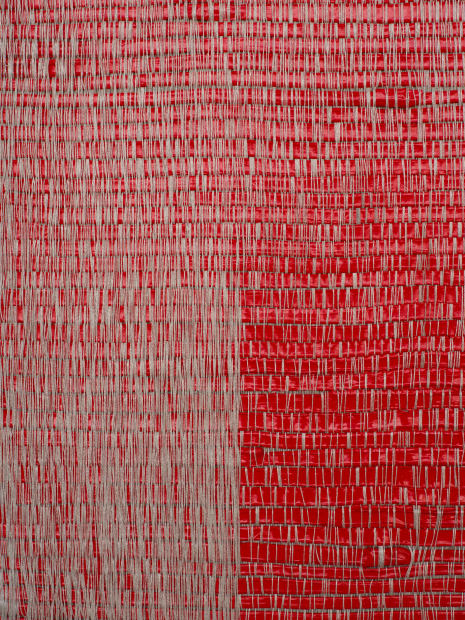
Analia Saban dissects and reconfigures traditional notions of painting, often using the medium of paint as the subject itself. This body of work continues Saban's investigations into the relationship between paint, pigment and canvas. In this work, thin layers of dried acrylic paint is woven through the linen, physically embedded into the fabric of the painting.


Informed by the worlds of art, architecture, natural sciences, and engineering, Saraceno's work invites viewers to consider geometries and phenomena of the natural world as adaptable models for the ways we live and interact. The piece is comprised of a complex geometric structure of translucent iridescent plexiglas that suggests the cell-like membranes of bubbles that emerge when oil is shaken with water. As in an organic system, this work is composed of many parts all similar but all different from one another, whose interconnected elements capture the iconic and intricate complexity of Saraceno's oeuvre.
